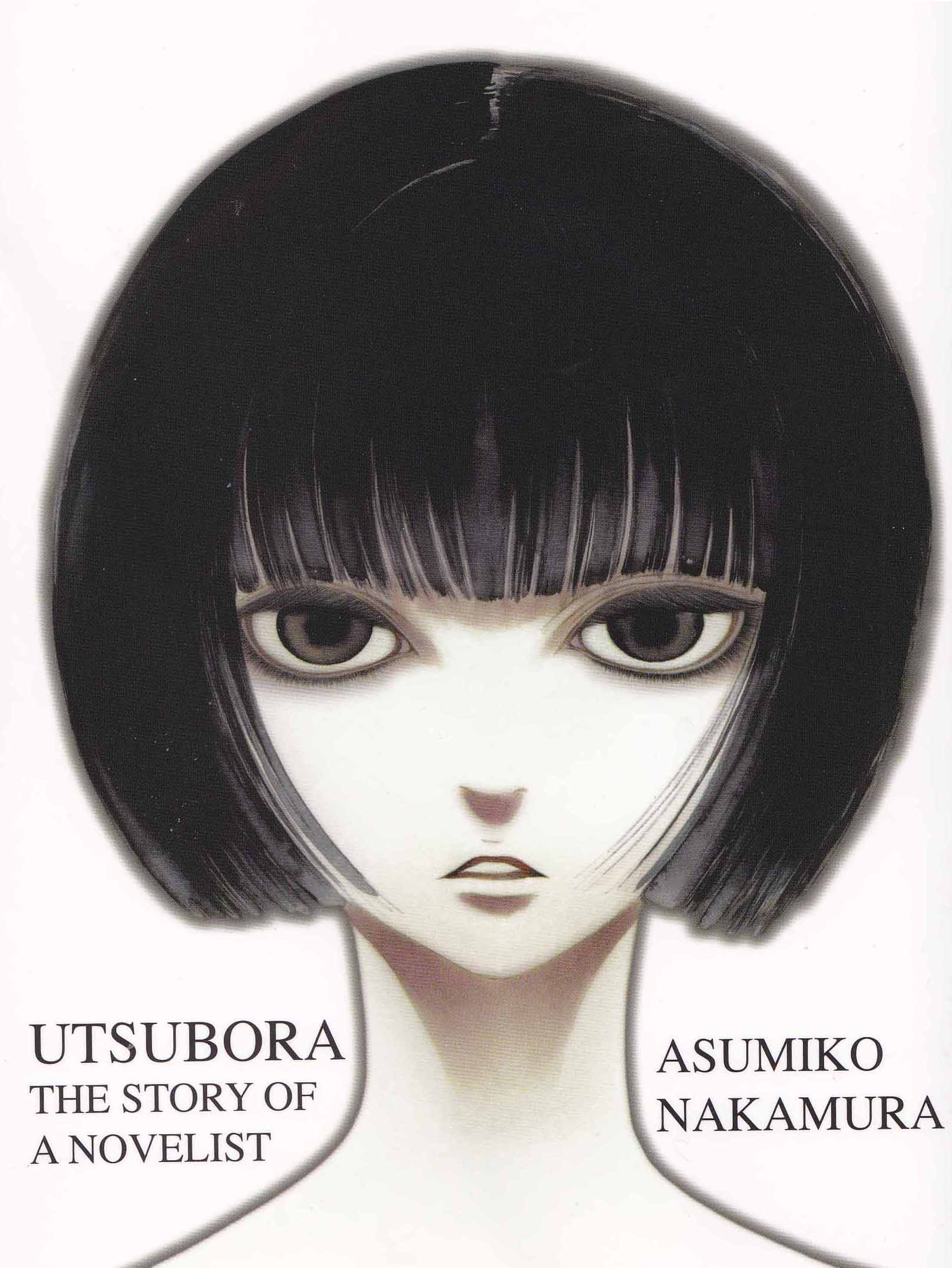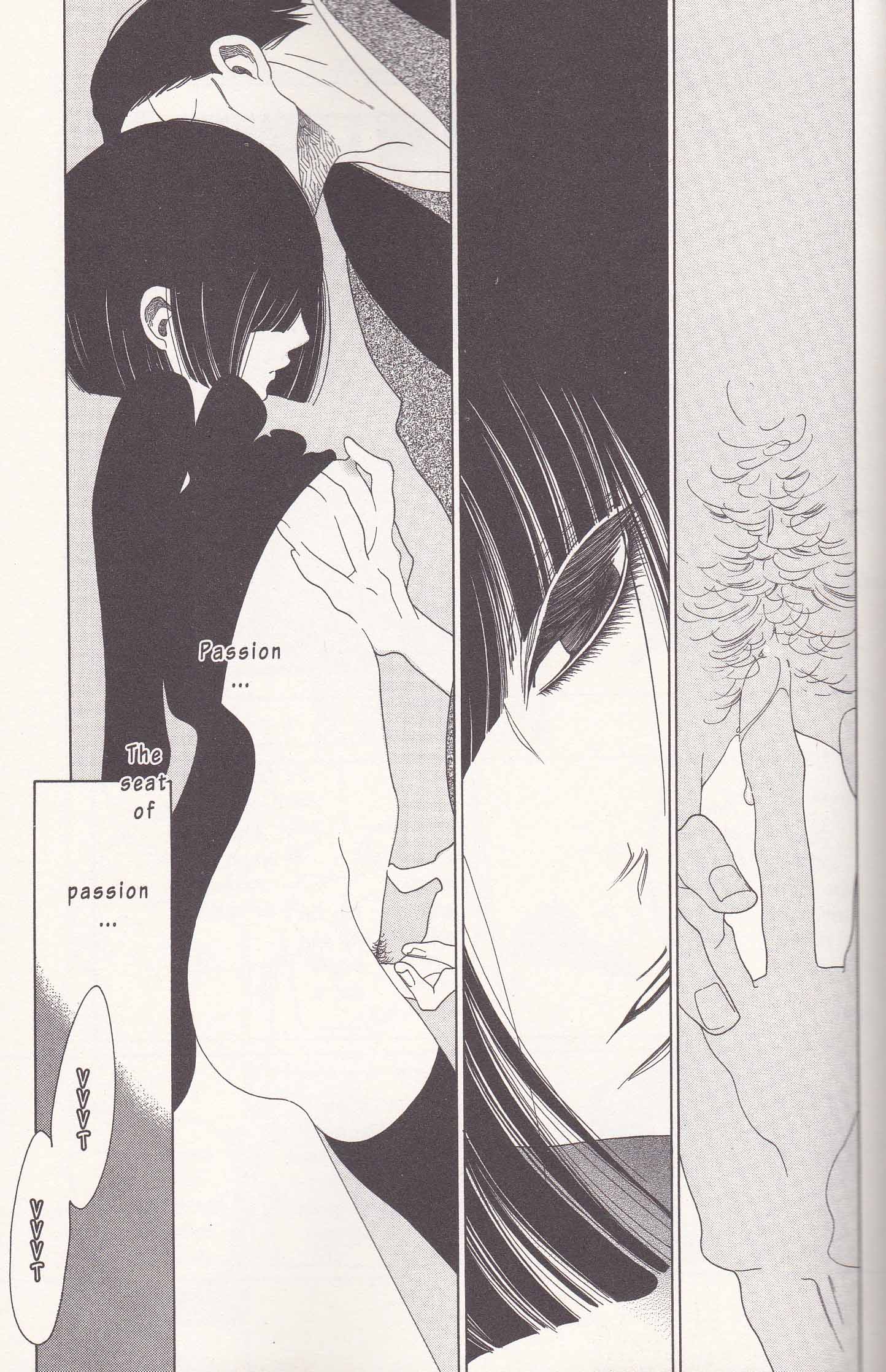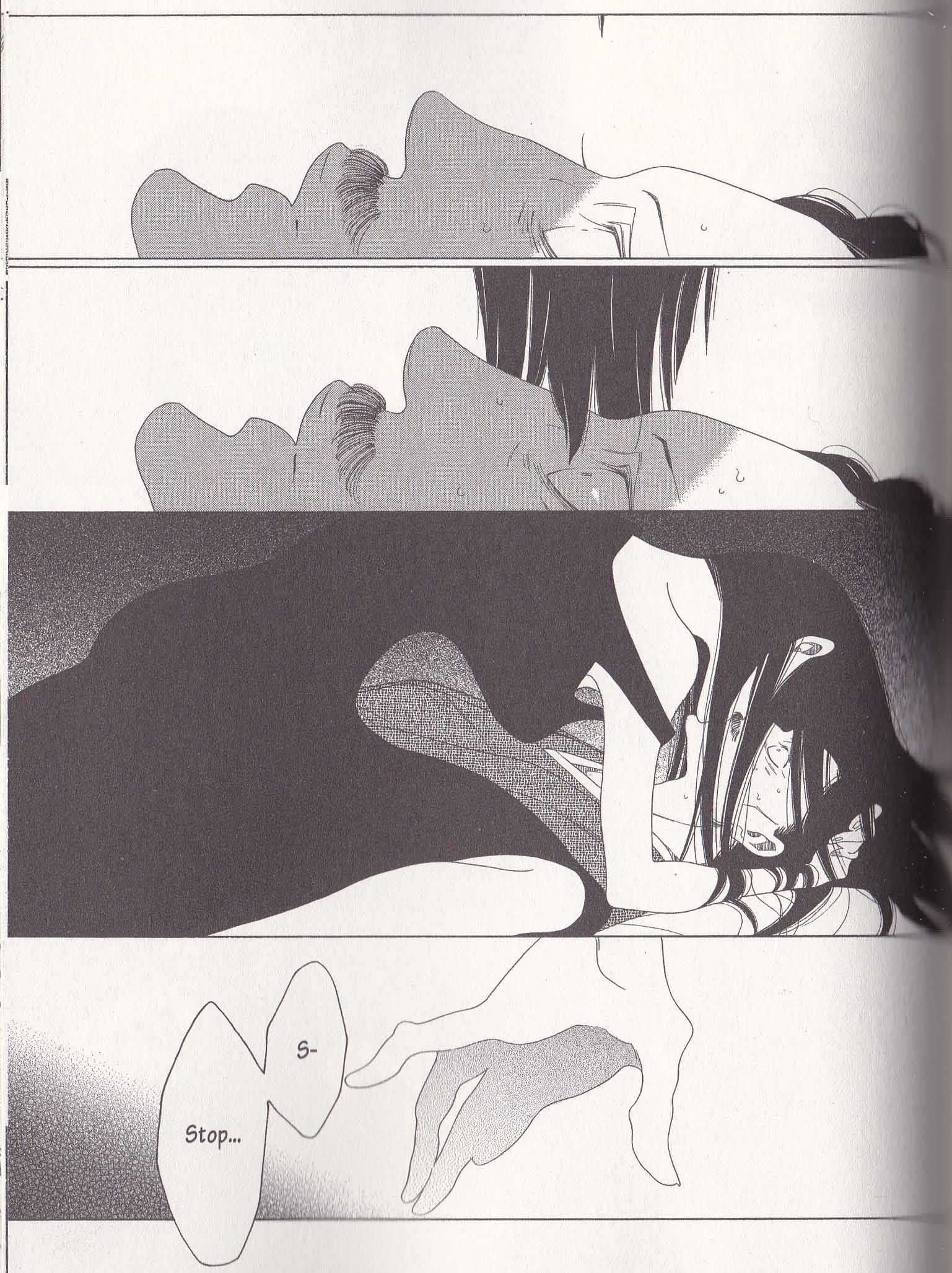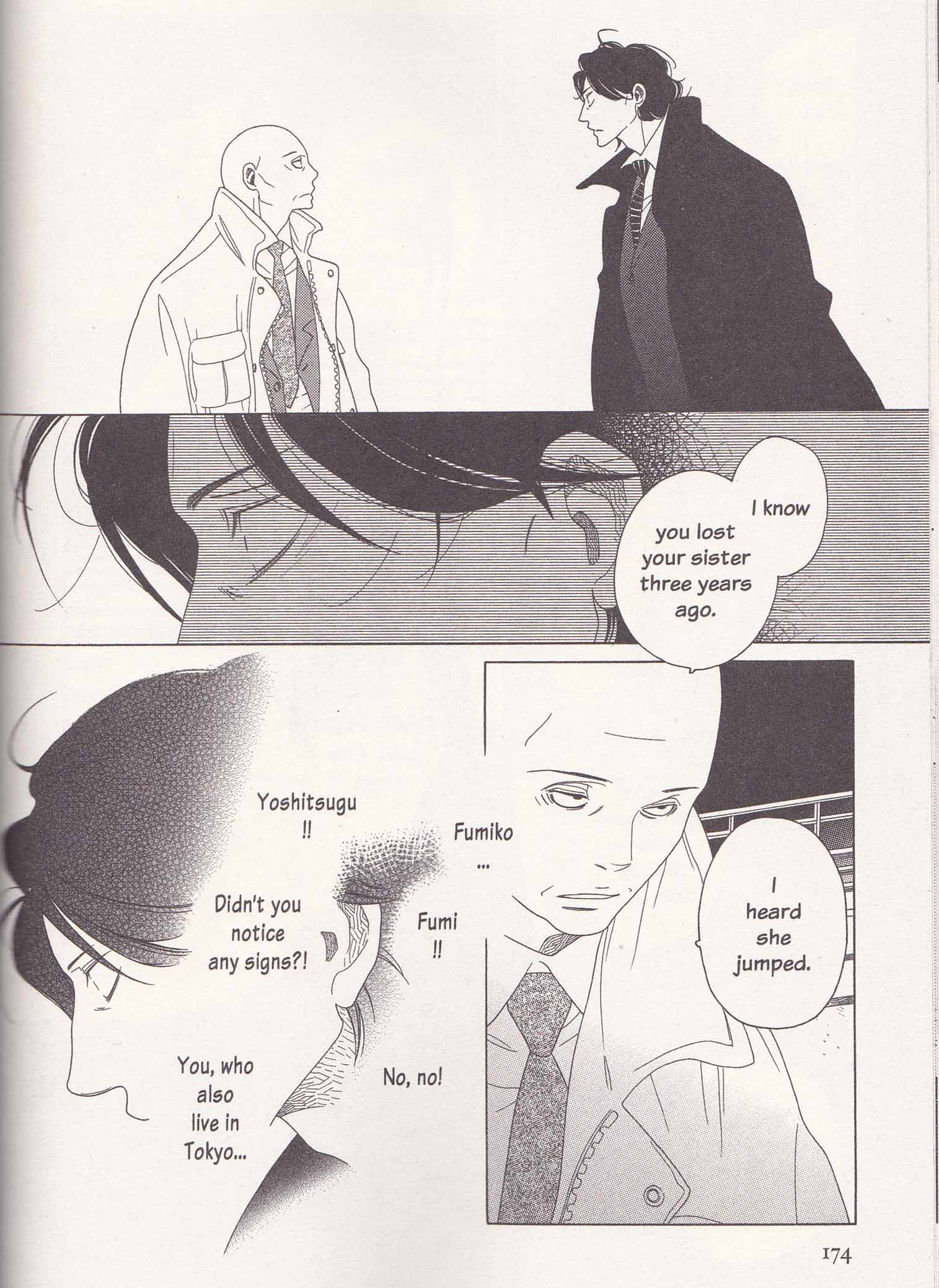“Utsu…means “depression” or “melancholy.” Tsubo…mean “urn.” …in addition to connotations of a hinter emptiness, the title strongly echoes nouns with a contrary impression of crude vitality… Utsubora is baffling yet familiar; negative yet animate; empty yet organic.” — the editor, Utsubora.
The word online is that Asumiko Nakamura’s Utsubora has had dismal pre-orders. First published in 2008-9 in the pages of Manga Erotics F, it has been released to a patter of enthusiastic notices (see reviews listed below) but little else. While eroticism might sound like a sure seller, this is less the case when it is sold under the guise of “literary” seriousness (the English language edition is by Vertical which does a lot of well-designed Tezuka). And there is certainly a vague kind of high-mindedness trying to crawl out of Nakamura’s manga which is ambiguously subtitled “The Story of a Novelist.”
In the opening pages, a pallid statuesque beauty jumps head first from a tall building leaving an unrecognizable mess on the pavement below. A famous novelist, Shun Mizorogi, is called in by the investigators to identify the body (thought to be that of Aki Fujino) a clearly impossible task since only her lower limbs are well preserved. As it happens, he is one of only two names on her phone contact list and hence a suspect. At the morgue, he meets the victim’s twin sister, a sphinx-like creature going by the name of Sakura Miki, a cipher who leaves a list of false contacts for the police but somehow clings to him in a symbiotic or perhaps parasitical relationship. He has been plagiarizing her sister’s (a budding authoress) manuscripts and becomes dependent on Miki for the remainder of his serialized novel which is also titled, Utsubora. The rest is a metaphorical ramble around questions of authorship and creation, played out in the mystery surrounding the lives of Aki and Miki.
One could be forgiven for assuming that the novelist of the subtitle (an editorial addition or in the original?) is the male protagonist whose fate structures the story, but Nakamura’s ambiguity is purposeful—that appellation refers not only to Mizorogi (the male author) but also the plagiarized suicidal authoress (Aki Fujino), and Nakamura herself. Aki and Miki are not so much characters but personifications of author and story. The “true” author of Utsubora is the woman (Aki) seen flinging herself head first to the sidewalk, a shadowy figure who is seemingly plain and unadorned but then transformed by means of surgery to the physical likeness of her friend and self-professed sister, Miki (the female protagonist of the tale).
This plastic surgery has less to do with soap opera conceits than the way an authoress’ appearance and personality is transformed ( in the imagination of her readers; and personally and insidiously) into something else—a physical likeness of similar, angelic temperament; mysteriously distant yet welcomingly sexual; a hidden, mythic, and unaging figure. A vision of how personal experience when turned to fiction can lead to the molding of the writer herself. We can detect a plot of similar temperament in Roman Polanski’s The Tenant where the actor-director becomes the object and victim of his fears in a movie of his own conception. In the structure and premonitions of Utsubora, we can see an echo of the fatalism of Nicolas Roeg’s Don’t Look Now—Donald Sutherland’s almost authorial paranoia in that film being the impetus of the plot and entire movie. It is this mixture of grief, writerly fixation, and eroticism which creates that tinge of horror in Nakamura’s manga.
Miki is the personification of Aki’s (and Nakamura’s) story. In deference to this, she is frequently seen conveying handwritten manuscripts to either Shun Mizorogi or his editor. At other times she is depicted against scattered sheets of drafts. The moment Utsubora is released in its final form by Mizorogi is also the moment she disappears from the manga as a character—turning at once into a caricature of the typical cheerful manga heroine—her job and reason for existing finally brought to a close. That segment of the manga where Mizorogi’s editor debates the primacy of the story over authorial credit seems a moment of metatextual self-realization, one might even say a kind of sentience on the part of the manga. It is easy to see a trace of personal experience in that conflict between the physical availability of a story and the act of plagiarism.
As for the eroticism, the authoress seems to take a singular delight in finger fucks but appears more abashed by actual coitus. Scenes involving the latter are broken up and defused through her panel work and other forms of obfuscation. The blow jobs depicted are undeniably squalid and damp; it is an act which is depicted with contempt and disgust.
One might see in this a decidedly feminine approach, the use of lengthy fingers being more readily available or even more attractive than the male sex organ (I have yet to read any of Nakamura’s Boy’s Love manga to confirm this). The reiteration of this device in comics will undoubtedly suggest the work of Guido Crepax to a Western audience—that arch student and adapter of all forms of literary smut. That penchant for gnarled, stringy hands inserted into orifices, as well as a boundless attraction to the sopping juices of a tight cunt are all hallmarks of that Italian cartoonist.
Nakamura’s delicate minimalism and elongated figures suggest the work of Aubrey Beardsley and the smattering of reviews I’ve read offer up an amalgamation of this Western eroticism and that found in Ukiyo-e in explanation of the final product (though examples from the latter seem considerably more frank).
Crepax’s vision suggests violence and control while Nakamura’s allows for desirability and fulfillment; an almost feminine coyness about the penis which is quite the reverse in Crepax where the male organ is an erect weapon.
Despite all this, there are immense difficulties for the would be reader before we get to that final moment of legerdemain. There are about 50 pages of scattered plot here fluffed out to 450 pages of mind numbing repetition of figuration and expression, as well as pointless nudity and pin-ups. All to often this is a suspense novel without any suspense, an exercise in eroticism without sensuality, a depiction of authorial obsession with nary any artistry—a torrent of metaphors with almost no consequence or real depth. It’s as if you bought a comic and all you got was paper and ink. The high page count and, one suspects, the pace of publishing has resulted in far too many pages of quite insipid mood, depiction of place, and composition. Only at the end does some form of concentrated artistry rear its head.
The flurry of barely developed plot devices is oppressive and infuriating. For instance, the incessant cradle snatching and the reassertion of the “natural” attraction of young girls for boring wrinkly, old farts (especially when they spend all day cooking for them)—all this clipped from the celebrated annals of incest in Japanese Adult Videos. Yes, even female mangakas can be idiots (or maybe ironic, it’s hard to tell). Tired tropes abound, it is almost as if dutiful eroticism had anesthetized creativity. And thus we have Aki as an assertive succubus, entrapping the author with her wiles and literature, her form transformed not by smothering the devil’s bottom with adulation but by heeding the surgeon’s knife.
The tear jerking moment when Nakamura lifts a plot point from episode Z of your favorite police procedural crap—the cop who gets overly involved because the victim reminds him of his sister (or was that wife, mother, or child)—is certainly incitement to book burning.
A trying experience then but one alleviated by a lengthy and well inscribed denouement—the solitary reason one might pause in the act of casting a copy into the outer darkness to mention this work at all.
_____
Other reactions
There aren’t many to choose from as yet but there’s a review by Sean Gaffney, another at Otaku Champloo, and finally one by Connie C..







Extremely strong contrast between your review and the others.
About the word “smut” (this is not about your use of the word, sorry, I don’t have anything to add to what you said)… I have no idea why people who create or enjoy porn use that word to describe the stuff. It just sounds utterly vile, like some evil smelling wet shit you have to muster the courage to clean up.
Not fond of the words “dirty” or “naughty” either, I don’t know why a sex positive people use them, doesn’t embracing the stigma just make you look worse to people who call you dirty in the first place? I know its very complicated but I think all porn people should question their creative use of all things dirty and shameful. I’ve tried to pinpoint all the symptoms of embarrassment about sex in peoples behaviour and its extremely difficult, especially since I’m not a behaviour expert.
Part of the appeal of porn often is that it’s dirty or taboo, though. People like that about it.
I’m not innocent. I’m guilty of liking things for slightly screwed up reasons, but I try to make as much sense of it as I can, a little bit of order too, even if it isn’t possible to iron out all the wrinkles or even understand what the wrinkles are.
I just get tired of people thoughtlessly continuing these things, especially in lame pinuppy humor with girls falling out their clothes. I certainly don’t have the answers, but I try.
I’m not even advocating people stopping with the dark stuff, but I think it needs some analysis before you commit.
I guess I just feel it’s unlikely that people who like porn are going to stop using words such as “smut” because it’s distasteful or ugly. If you’re consuming porn, distasteful and ugly is probably not seen as a bad thing, and may even be a feature.
Not that I’m against analyzing or thinking about porn. I’m just saying that I don’t think your hopes in this area are likely to be fulfilled.
Are the words “smut”, “dirty”, and “naughty” used in relation to porn really suggestive of anything ugly or disgusting? It seems to me that publishers/pornographers like Fantagraphics see these terms as marks of humor (as in wink wink, nudge nudge; a la Monty Python). They’re like the “Hey Kids, Comics” of porn publishing, hence the almost childish connotation of the words.
“Naughty” sounds playful. “Dirty” and “filthy” remind me of bad hygiene. “Smut” sounds utterly stomach churning.
Perhaps these are very personal responses on my part.
There are a lot of words in porn used in a positive way that sound bizarre or insulting. Large robust women are often described as “brick shithouses”, who thought that sounded like a compliment?
Noah- I’m sure you’ve saw that there are blogs by porn enthusiasts who analyse things in a way similar to this blog, and although I’d never expect the majority to get interested in this stuff, I really think there are a lot of people who might really be interested who don’t currently read this stuff, because a lot of people want to know what kind of person they are, a lot of people are troubled by the implications of what they’re into and go looking for perspective on it, the self-discovery element is important and I think for most people it bleeds into more general concerns about themselves.
This is a pretty decent piece you might like…
http://www.pbs.org/wgbh/pages/frontline/shows/porn/special/eloquence.html
…about porn reflecting the times. You often see these old racist caricatures in old porn with professors talking about them and it makes me think that all those vile Sarah Palin cartoons are going to be studied in museums someday.
I’m afraid I have to disagree about the quality of the article. While it had some interesting and important points they where surrounded by too much middlebrow flailing unfavourably reminding me of a high school social science textbook or the culture pages of The Economist, like it had knocked them off a higher shelf by accident.
Huh…it doesn’t seem anything like the Economist’s culture writing to me. Among other things, the Economist would never cover something like this in a million years….
On closer inspection it’s actually an excerpt from a book and not a solitary article, so it’s inevitable to be stunted. As the full work would expand on the ideas now superficially introduced it could be a very interesting work.
As it stands, the text is problematic. The first is the attempt to legitimise pornography as a field of study by de-legitimising pornography itself. It’s not actually about fondling your genitals, “Pornography is thus a form of political theater. It’s a medium for confronting audiences with exactly those contents that are exiled from sanctioned speech, mainstream culture and political discourse. And that encompasses more than sex.” “But looking at pornography wouldn’t be an issue worth bothering about unless there were more at stake than sexual pleasure. And while I hardly mean to malign sex, which has enough bricks thrown at it these days, it isn’t the only reason pornographic fantasy is worth fighting for.”
Stating that the primary “rule” of pornography is transgression (and the resulting struggle against political (??) repression), and that its rules of genre somehow expands it to form the very cellular wall of culture itself instead of leaving it yet another mannered globule somewhere in the middle is not as bad as trying to take the sex out of porn, but hardly supported by the text as it stands.
Regarding similarities to The Economist, expanding that thought would require a more substantive effort so’ll have to wait. I’ll see if I can find any reviews of the book, even if I disagree with it it could still prove a worthwhile read.
Well, talk about synchronicity. The next day after I hear of Laura Kipnis for the first time she’s casually mentioned alongside Linda Williams in a major article in the largest morning paper… I suppose I just revealed my lack of breading.
I like this piece. But pornography is sort of the ultimate example of sanctioned transgression, though, isn’t it? There’s definitely something about pornography that allows it to link to other forms of creative marginality and impoliteness, just like drunkeness is a blessing and a curse of grownup adolescence.
…and lack of breading is fine if you’re cutting down on carbs.
(I’m the worst typo typer ever, don’t mind me)
Kipnis’s Against Love: A Polemic is a wonderful book — and, ironically, was the source of a slight academic crush on my part.
As an avid admirer of Asumiko’s work, I was surprised to be so disappointed in Utsubora. And your review put the words to my feelings. I think she’s trying to do too much with Utsubora, putting forward her brand of Gothic and erotica (what she’s famous for) topped with what seems like an effort to be both ‘commercial’ and literary (what she couldn’t achieve in the works she’s famous for). perhaps the only reason I keep it is that in the end it’s as if Asumiko, too, is bemoaning being caught in the author’s trap of her own tale, or the artist in her art.
Hopefully Utsubora is but a stepping stone to greater works.
That’s interesting. Utsubora is the first thing I’ve read by Nakamura and bought on the basis of whatever hype I read at the time. If only you had written a review telling me to avoid!
This particular book might have worked better at half its length – i.e. minus all of the B-grade filler.